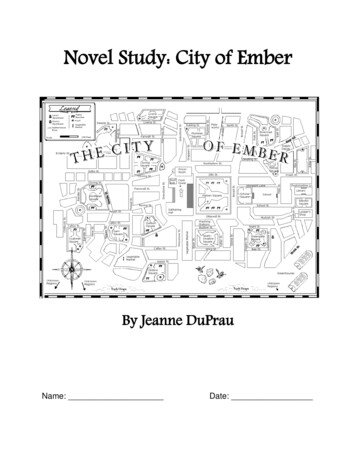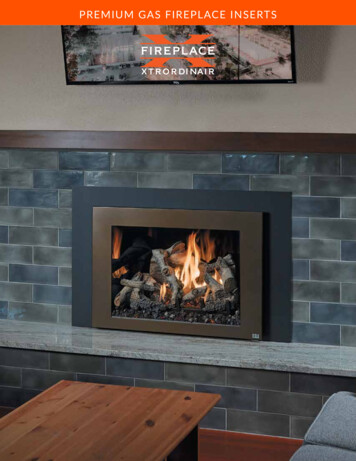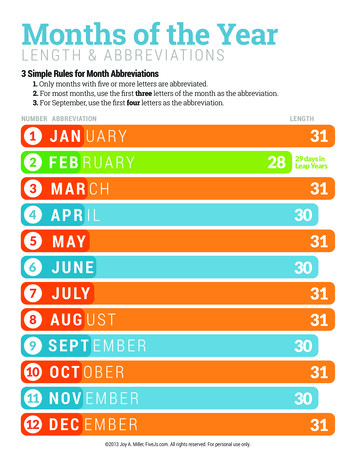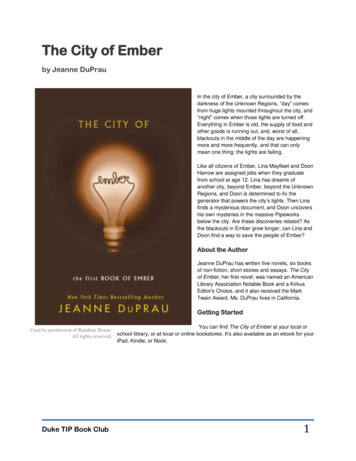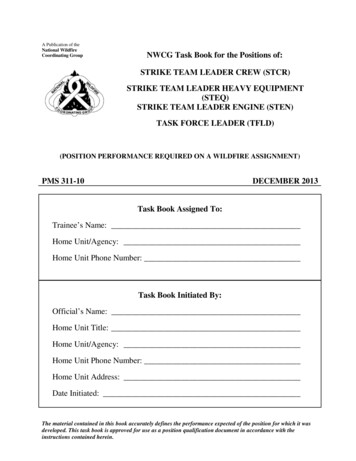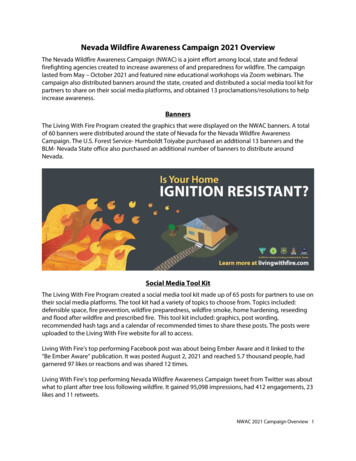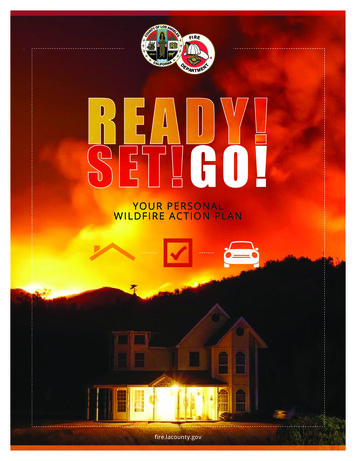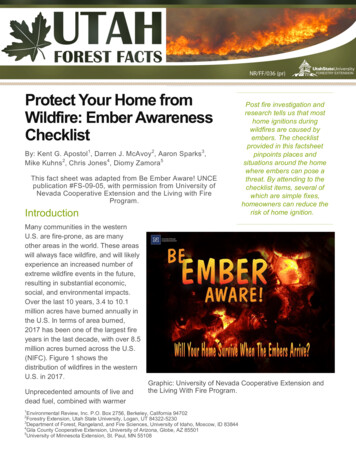
Transcription
Protect Your Home fromWildfire: Ember AwarenessChecklistBy: Kent G. Apostol 1, Darren J. McAvoy2, Aaron Sparks 3,Mike Kuhns 2, Chris Jones 4, Diomy Zamora 5This fact sheet was adapted from Be Ember Aware! UNCEpublication #FS-09-05, with permission from University ofNevada Cooperative Extension and the Living with FireProgram.IntroductionMany communities in the westernU.S. are fire-prone, as are manyother areas in the world. These areaswill always face wildfire, and will likelyexperience an increased number ofextreme wildfire events in the future,resulting in substantial economic,social, and environmental impacts.Over the last 10 years, 3.4 to 10.1million acres have burned annually inthe U.S. In terms of area burned,2017 has been one of the largest fireyears in the last decade, with over 8.5million acres burned across the U.S.(NIFC). Figure 1 shows thedistribution of wildfires in the westernU.S. in 2017.Unprecedented amounts of live anddead fuel, combined with warmer1Graphic: University of Nevada Cooperative Extension andthe Living With Fire Program.Environmental Review, Inc. P.O. Box 2756, Berkeley, California 94702Forestry Extension, Utah State University, Logan, UT 84322-52303Department of Forest, Rangeland, and Fire Sciences, University of Idaho, Moscow, ID 838444Gila County Cooperative Extension, University of Arizona, Globe, AZ 855015University of Minnesota Extension, St. Paul, MN 551082Post fire investigation andresearch tells us that mosthome ignitions duringwildfires are caused byembers. The checklistprovided in this factsheetpinpoints places andsituations around the homewhere embers can pose athreat. By attending to thechecklist items, several ofwhich are simple fixes,homeowners can reduce therisk of home ignition.
University of Arizona Cooperative Extensionhas also produced fire mitigation educationmaterials to help communities understand howto coexist with wildfire. Please visit https://extension.arizona.edu/pubs and type “wildfire”in the search box for specific Firewise defensible space materials. This fact sheet wasdeveloped to help you and members of yourcommunity understand the danger of embersduring a wildfire and take proactive steps toreduce the risk.What are Embers?Figure 1. Distribution of wildfires in the western U.S. in2017. In the western U.S. alone, nearly 1,000 wildfireshave occurred, mainly from April to October. Wildfirespatial data (fire perimeters) were acquired from theGeospatial Multi-Agency Coordination (GeoMAC),which uses a combination of aerial and satellite firedetection methods to map wildfires. Fire perimetersare enlarged for visibility purposes.temperatures, decreased snowpack, andearlier snowmelt, will likely lead to drierconditions and increased fire activity in the nextfew years. In fact, over the coming decades,the number of days conducive to extremewildfires is predicted to increase by 25-50% inthe western U.S., with larger increases in thesouthwest U.S. (50-75%).There are several resources available on howto enhance the protection of communities fromwildfires. For example, visit Utah StateUniversity Forestry Extension web pages onwildland fire safety: -interface. TheDuring a wildfire, thousands of burning embers,or “firebrands”, can be carried by the wind andcan rain down on your home (Figure 1). Theseembers can be parts of twigs or branches, pinecones, or wood shingles torn from burningroofs. Such embers are not just an interestingbut unusual occurrence with wildfires; they arethe leading cause of home ignitions duringwildfires. Most (at least 50%) home ignitions inwildfires are started by burning embers thathave been transported through the air from anactive wildfire (Mell et al. 2010).How do Embers Spread Fires?When embers land on or become lodged ineasily ignited materials on or near your house,they ignite those materials. This means thatmost fires start from embers that are thrownsome distances from the flames. Then thesespots burn and the small fires coalesce andthen burn across the landscape. The classicimage people have of a fire spreading across alandscape as flames leap from tree to treehappens, but fires spotting ahead of the mainfire is also very common.During wind-driven or very intense fires, somany embers are produced and transportedthat they are often called ember showers,storms, red snow or blizzards and they canignite spot fires far from the active front of a2
wildfire. Embers present hazards because theycan either directly ignite components ofvulnerable structures or they can ignite nearbyvegetation and other combustibles. Thesesmall fires can subsequently ignite the structurevia radiant heating or direct flame contact(Quarles 2012). Consequently, even homeslocated many blocks and up to a mile awayfrom the main fire are vulnerable to ignition anddestruction.Carolina. Their main research objective is toreduce the likelihood of wildfire-caused buildingignitions in communities located in wildfireprone areas. Based on their demonstrationtrials, the IBHS shows how important embersare for igniting homes (Figures 2 and 3).If there is no organic surface debris, such asneedle litter adjacent to walls, in the raingutters, or next to the roof dormer, embers aretypically not sufficient to ignite a structure,according to research conducted by theInsurance Institute for Business & Home Safety(IBHS) (https://disastersafety.org/wildfire/). Adormer is an additional roofed structureprotruding outward from of a sloping roofsurface. IBHS has developed the capability ofsimulating ember and radiant heat exposureson building components and assemblies attheir research facility in Richburg, SouthWith a large fire in the vicinity, you will not beable to prevent burning embers from landing onyour landscape and your home. If the windblows toward your property from the direction ofthe main fire, you will get embers. Whether theywill become a large fire that will seriouslythreaten your home depends on what you do tomanage fuels on your property. Embers thatland on non-flammable surfaces like pavementor bare soil will burn out and will not threatenyour home. Embers that land on small,localized fuel accumulations and start smallfires, will use up that fuel and then burn out, butIgnition Prevention ComesDown to Managing FuelFigure 2. Ember storm produced in the IBHS research facility. Photo: Jack Cohen, USDA ForestService and IBHS.3
Landscape plants should be chosen for smallsize, moistness, and low flammability. For a listof firewise plants for Utah see ic: University of Nevada CooperativeExtension and the Living With Fire Program.“.the key to preventinghome ignition is tomanage the availablefuel – the landscapeplants, attachedstructures like decksand fences, and thehome itself.”The landscape should be designed to isolateclumps of fuel (plants) with less flammablesurroundings. The landscape must bemaintained through mowing, pruning, anddeadheading, and debris must be removedfrom roofs and gutters (Figures 3 and 4). Woodroofs and decks should not be used. Thebuilding also should be designed andmaintained to prevent embers from enteringthrough openings (an open window or vent forexample) and ignite furnishings in the buildingor debris in the attic.Ember Awareness ChecklistIf an ember landed next to your home or in yourrain gutters (Figures 3 and 4), would there be“fuel” for it to ignite? The Ember AwarenessChecklist (Figures 5a and 5b) identifies 20points on or near your house that arevulnerable to embers and provides steps thatcan be taken to help prepare homes for embersand reduce the risk of ignition. In addition to thechecklist in Figure 5A, a couple of steps areworth considering. Close heat resistant drapesthey will not threaten your home because oftheir isolation. The embers that will threatenyour home are those that land on larger,continuous accumulations of fuel that canburn up to the home or that will land on fueladjacent to the home itself.Whether a fire is sweeping across thelandscape with dramatic flames or spottingfrom firebrands, the key to preventing homeignition is to manage the available fuel – thelandscape plants, attached structures likedecks and fences, and the home itself.Figure 3. Pine needles burning in a rain gutter.Photo: Jack Cohen, USDA Forest Service andIBHS.4
Figure 4. Burning pine needles in the rain gutters and burning pine needle debris on the roof againstthe dormer (on the right). This dormer is representative of vulnerability to embers that occurs on a“complex” roof, particularly at roof-to-siding intersections. Photo: Jack Cohen, USDA Forest Serviceand IBHS.or curtains and non-combustible shutters ofwindows if wildfire is threatening. Parking awayfrom the house is recommended but thechance of vehicle burning if adjacent toflammable materials increases.Most of these steps amount to managing fuels.The Insurance Information Institute sees thatfewer houses were lost to wildfire in recentyears particularly as homeowners took stepssuch as clearing trees/brush away frombuildings, keeping firewood stacks and propanetanks at least 30 feet from the home andinstalling screens over dwelling openings tokeep embers out (Ruiz, Janet, personalcommunication). So the future looks bright if wedo the right things.5
Figure 5a. Ember Awareness Checklist. Graphic: University of Nevada Cooperative Extension and the Living With Fire Program.6
Figure 5b. Locations around the home showing vulnerabilities to embers. Graphic: University of Nevada Cooperative Extensionand the Living With Fire Program.7
ReferencesGeospatial Multi-Agency Coordination(GeoMAC). https://www.geomac.gov/index.shtml. Accessed 9/11/2017.Mell, W.E., Manzello, S.L., Maranghides, A.,Butry, D., and R.G. Rehm. 2010. The wildland–urban interface fire problem – currentapproaches and research needs. InternationalJournal of Wildland Fire 19, 238–251.doi:10.1071/WF07131National Interagency Fire Center. https://www.nifc.gov/fireInfo/fireInfo statistics.html.Accessed 9/19/2017.Quarles S.L. 2012. Vulnerabilities of buildingsto wildfire exposures. pp 1–13. ilities-of-buildings-to-wildfireexposures. [Last Accessed May 01, 2016]Acknowledgement and additionalinformationWe thank the Washington State ConservationCommission (16-34-FW) Firewise funding to theCentral Klickitat Conservation District (KGA).Firewise, Fire Adapted Communities, ReadySet, Go (www.wildlandfirersg.org), Firewise, FireAdapted Communities seek to share informationwith residents on what you can do tosuccesssfully prepare for a wildland fire. Pleasecontact your local fire department, Forestry, Fireand State Lands, Bureau of Land Management,or US Forest Service officeor www.utahfireinfo.gov to learn about yourarea’s threat for wildland fire and the wildlandurban interface.Ruiz, Janet. 2017. Personal Communication.September 15, 2017.Smith, E.G. and S. A. Sistare. 2009. Be EmberAware! University of Nevada CooperativeExtension. FS-09-05. 6p.Utah State University is committed to providing an environment free from harassment and other forms of illegal discrimination based on race, color,religion, sex, national origin, age (40 and older), disability, and veteran’s status. USU’s policy also prohibits discrimination on the basis of sexualorientation in employment and academic related practices and decisions. Utah State University employees and students cannot, because of race, color,religion, sex, national origin, age, disability, or veteran’s status, refuse to hire; discharge; promote; demote; terminate; discriminate in compensation;or discriminate regarding terms, privileges, or conditions of employment, against any person otherwise qualified. Employees and students also cannotdiscriminate in the classroom, residence halls, or in on/ off campus, USU-sponsored events and activities. This publication is issued in furtherance ofCooperative Extension Work, Acts of May 8 and June 30, 1914, in cooperation with the U. S. Department of Agriculture, Kenneth L. White, VicePresident for Extension and Agriculture, Utah State University. Published August 2018.6
Mike Kuhns2, Chris Jones4, Diomy Zamora5 situations around the home This fact sheet was adapted from Be Ember Aware! UNCE publication #FS-09-05, with permission from University of Nevada Cooperative Extension and the Living with Fire Program. Introduction Many communities in the western U.S. are fire-prone, as are many other areas in the world.
